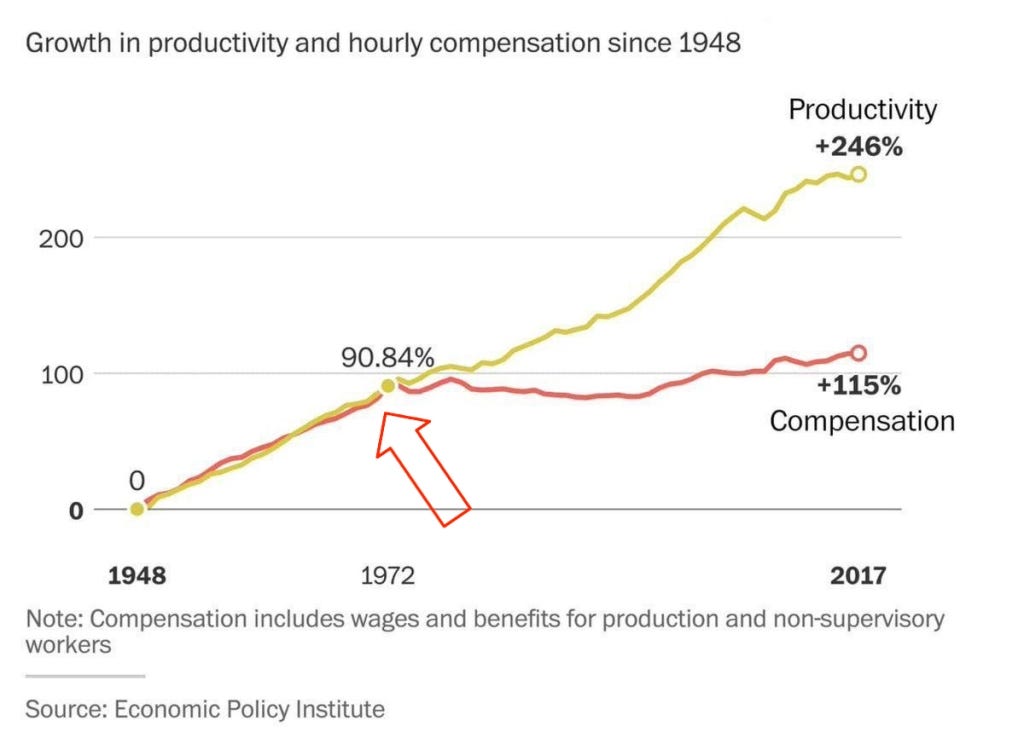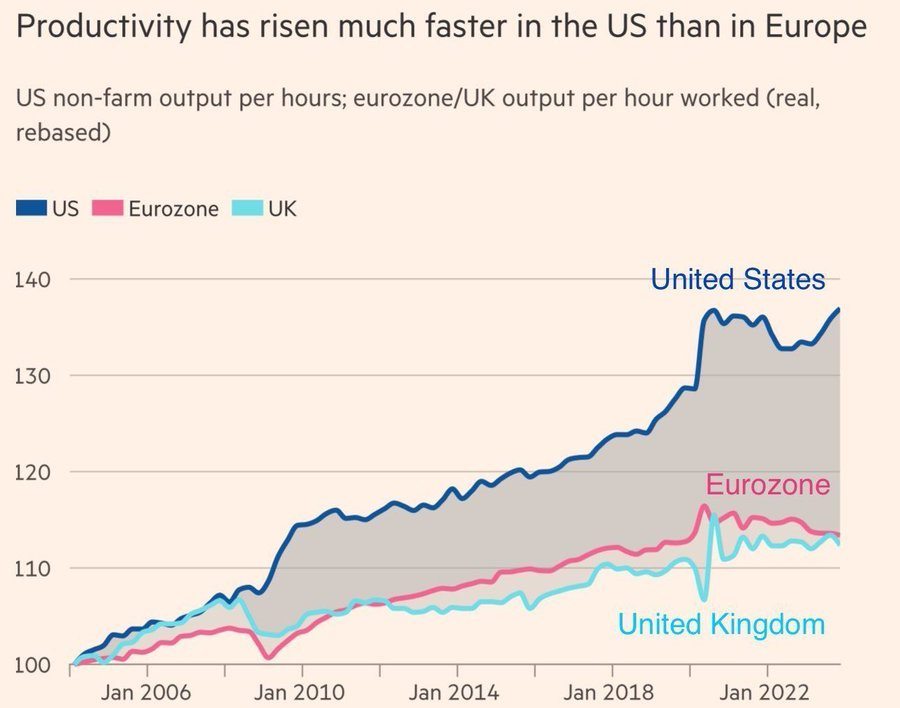What I learned this Week: January 19, 2025
Why GLP-1, Creative Destruction, and a stubborn system that resists change signal the end of business as usual
Lessons of the Week
Despite the ever-increasing data suggesting that GLP-1 alters what people choose to eat, consumer product goods companies remain focused on relabeling products to appeal to GLP-1 patients. But not reformulate products. Healthcare is frustrated that direct-to-consumer healthcare companies like Hims/Hers are taking patients. But tradtional healthcare is slow to rethink care delivery. Agriculture is seeing downward price pressure on commodity crops from global overproduction, with no end in sight. Yield is not an issue, but investors, for some reason, think yield still matters. While Ag, Health and Food need new technology to adapt, venture capital struggles to survive and attract investment from a booming stock market.
Nothing seems to be working like it did. When the incumbents are stuck in their business models with declining profitability, the gales of Creative Destruction strike hard.
Near-death experiences in startups suck, but it is a great opportunity for those with the stamina and insight to survive.
What I learned this week….
Once you understand evolution knows more about health than science, better health is cheap.
It is hard to tell if my doctor is a health provider or a drug rep
The next generation of obesity drugs are even better. Could this trigger disruptive pressure to improve the food system? Or will it let ultra processed foods continue?
The failure of AgTech does not make US agriculture more competitive. #MAHA can not invent a better food system out of thin air, it will require innovation. It still requires the assembly of a lot of investment capital.
It is unclear whether Climate Smart funding over the last 4 years did anything more than prop up the companies Creative Destruction would have removed. Delaying the maturation of technology needed to keep US agriculture competitive. And Slowing Food is Health.
A high-quality gut microbiome may tolerate low-quality feed/food, and still deliver high-quality nutrition to animals. It makes evolutionary sense that our guts adapt to what we can find to eat. This further confuses the value of specialty soy vs. commodity meal mixed with DDGs.
A couple of MIT grad students recreated the Spanish flu in their lab. While MIT is unique, the barriers to biological weapons of mass destruction are falling, and the futility of biowarfare treaties.
Missiles now kill more commercial jet passengers than accidents. A statement on the incredible quality of airline safety.
Oreos may outlast cockroaches in a nuclear war
People in LA steal fire hydrants. Not sure why.
Here’s the inconvenient truth: you can’t fix healthcare until you fix health, you can’t fix health until you fix diet, and you can’t fix diet until you know what’s wrong.
Dr. Robert Lustig
Some Data and Links
Retro Biosciences: OpenAl is using a new model tuned for longevity research in concert with Retro Biosciences, a company trying to add ten years to the average human lifespan. Sam Altman invested $180 million into Retro in 2022. While Open AI has focused on very broad AI work, creating domain specific vertical models could create a great deal of competitive advantage. Palantir has been a leader in building domain-specific models in defense, government and some other markets. The gating function on model quality is likely training datasets. It is unclear in longevity and food is health who has the best datasets. Companies like Alden Scientific have and is extending a strong data set around human proteomics. Other select companies in food/health systems such as Earth Optics, Miratera, Benson Hill, Bright Seed, Holobiome, Metha AI, Sun Genomics, Viome, Flywheel and Edacious, have built longitudinal datasets from soil up through human health.
Cognitive Behavioral Therapy: Researchers working on mental health, specifically Cognitive Behavioral Therapy, are making progress on an autonomous multi-agent framework for Cognitive Behavioral Therapy to help supplement/augment psychological counseling. Access to good mental healthcare is needed for Food is Health treatment. Using AI to scale capacity and reduce treatment friction may help accelerate the shift in diet and overall health.
AI Accelerates Learning in Underserved Areas: Generative AI is revolutionizing education by providing tailored, accessible learning solutions, particularly in underserved regions. A pilot program in Benin City, Nigeria, showed students achieving nearly two years of typical learning in just six weeks through AI-supported tutoring. Participants outperformed peers in English, digital skills, and general academics, with girls making significant strides in closing gender gaps. The program highlights AI’s potential to democratize education, enabling students to learn independently and thrive despite resource limitations. This innovative approach could reshape global education by accelerating learning and bridging gaps in remote areas.
Strategic Threats: Data centers become military targets once we are capable of AGI. Countries lacking such advanced AI may feel inclined to aim their nuclear weapons on computing infrastructure rather than missile silos, military bases, and major cities. Kansas farmers are breathing a sigh of relief.
Is GLP-1 Innovation to Fast for Food: The upcoming generation of obesity treatments promises remarkable advancements, building on the achievements of medications like Ozempic and Wegovy. A recent study by researchers at McGill University emphasizes experimental drugs such as retatrutide, which has allowed trial participants to lose more than 20 percent of their body weight by mimicking hormones that regulate hunger. Currently, in phase 3 trials, retatrutide has shown notable weight loss in just 48 weeks. With numerous new therapies under development, the landscape of obesity treatment is poised for rapid expansion. While CPG firms resort to repackaging existing ultra-processed food with a GLP-1 friendly label. (Gizmodo)
Microbes as Sensors: Microbial sensors can generate extensive temporal and spatial data that actively influence human activities. This capability includes improving fertilizer usage to mitigate runoff pollution, identifying the local sources of environmental contaminants, and detecting harmful pathogens. A recent Nature article discusses an autonomous microbial sensor designed to detect TNT in natural soil. This technology utilizes computationally engineered riboswitches and genetic memory systems, enabling bacteria to recognize and react to minute quantities of explosives over time. Unlike conventional methods, these biosensors are self-sustaining, scalable, and versatile. As the technology progresses, it may be employed to track toxic substances in water and soil or forewarn about dangerous incidents such as gas or oil leaks. What works in the soil microbiome, could also work in the human gut - creating a new assay for metabolic health. (Nature)
Startup raises at a $10.2B valuation to revive extinct species: Colossal Biosciences, a biotech startup, has raised $200 million on a valuation of $10.2 billion. Who said VC was dead? The company plans to leverage advanced genomics to resurrect notable species, including the woolly mammoth, dodo, and Tasmanian tiger. In addition to de-extinction efforts, Colossal is developing preservation tools for endangered species, such as vaccines for Asian elephants and genetic improvements for bird populations. The company has spin-offs tackling issues like plastic waste and fertility solutions. By integrating de-extinction with innovative conservation strategies, Colossal is paving the way for a new era in restoring biodiversity. In an era of growth and innovation, will we need to worry about snail darter if we can revive a species? Perhaps a new form of insurance? (Bloomberg)
Boom Supersonic is breaking the sound barrier: Commercial supersonic travel is on the verge of a resurgence, with Boom Supersonic’s XB-1 prototype achieving a transonic speed of Mach 0.95 during its 11th test flight over California’s Mojave Desert. The 44-minute flight demonstrated the XB-1’s capability to withstand extreme dynamic pressure at near-supersonic speeds, which is essential for future performance and flight control systems. Boom is spearheading efforts to revive commercial supersonic travel. While Boom continues to receive funding support from tech entrepreneurs, I still question the need for supersonic flight. The Concorde failed as a commercial enterprise partly because people did not feel the need to pay so much more for a few hours saved in flight. (New Atlas)
The Cost of Bioweapons is Two MIT Phds in a lab: Two graduate students at MIT demonstrated how freely available genome data allows anyone with the proper skills to assemble the deadly Spanish Flu. The exercise exposed gaping holes in global biosecurity, which is not a shock because most policymakers do not understand much about science. With little learned from Whuan, 36 out of 38 gene providers shipped hazardous DNA fragments without sufficient checks, showing how easily malicious actors could exploit the system. Current safeguards fail to block evasive strategies like camouflaged DNA orders. Not sure why this is so hard to anticipate, Tom Clancy outlines the capability in his book Rainbow Six in 1998, in which a billionaire environmentalist creates an Ebola virus and binary bioweapon, masked as a vaccine to kill most of humanity and save the planet. Luckily, John Clarke saved the day. (ACSH)
Will AI Save Humanity: According to a McKinsey report, many of the richest nations must double or even quadruple their productivity growth to maintain living standards. Countries such as Germany, Japan, and Italy are experiencing a decline in working-age populations, which threatens slower economic growth and raises costs for younger generations tasked with supporting retirees. Despite working longer, Japan’s GDP per capita has only increased by about one-third of the U.S. levels over the last 25 years. The demographic challenge is both inevitable and substantial; when it occurs, enhancing productivity growth becomes even more crucial. As astute management consultants, McKinsey warns that without prompt reforms, the demographic challenge could undermine intergenerational wealth transfer, strain economies, and dampen prospects for future generations. Interestingly, it appears that AI, along with NVIDIA and Silicon Valley, has timed its entry perfectly, offering the potential for significant productivity gains. Instead of heralding our downfall, AI may actually enable humanity to work more efficiently, counterbalancing the effects of a declining birth rate. (FT)
YIMBY v. NIMBY: The YIMBY, NIMBY, and land use reform movements are energized by the lack of available housing. My personal opinion is the NIMBY and YIMBY movements have been infiltrated with rent-seeking miscreants with impure intent. Various political factions are looking to nationalize zoning to prevent limitations on land use in existing cities. While the housing shortage likely has a lot to do with high interest rates, and the YIMBY movement in cities has a lot to do with governments trying to reset land values higher to increase tax revenue, why not just build some new cities? Only 5.4% of the US is developed. Instead of turning existing cities upside down, build elsewhere. Where is Robert Moses when you need him?
GenCast: Google’s new AI weather model which gives us the probabilities of different weather conditions up to 15 days ahead with state-of-the-art accuracy. If we get the weather right all the time, how will that impact crops, transportation, financial markets and disaster management? And if the government is already controlling the weather, what will they do once we have the truth? (Link)
This Weeks Charts
What the Hell Happened in 1971: In 1971 we saw the beginning of a divergence in compensation from productivity. Economists have many explanations for the divergence. One is the entry of women more freely into the work force and the change to dual family income. Essentially a doubling of the available workforce.
Milk Production: Just as yield per acre took off since 1945 in the United States, so too has milk production. In large part through changing genetics made available through artificial insemination.
Tough Time on the Farm: Innovation from seed and tractors has made the US the most productive agriculture system in the world. Now, anyone globally can buy the same seed and tractors. The innovation in US agriculture over the last 75 years is widely available. US farms are now in trouble as commodity prices decline from global over supply.
The US Food system must innovate to differentiate itself from the broader commodity system or suffer. If anyone can buy the technology, how you put the technology together to deliver a service creates differentiation. All you need to do is look at the AI market to see a range of firms shape commodity LLMs into new value.
Fairlife had the same milk production capability as other dairy farmers. They applied new filtering technology and branding to improve nutrition, taste, and function. They created new value by focusing on consumer needs rather than commodity scale.
The concept of Fairlife in milk is available to every product in grocery from Chicken to Cheetos. Each can be reshaped to deliver better nutrition at roughly the same price by working up and down the value chain to integrate better attributes and features in the product from soil, seed, growing, processing, and delivery to the consumer. Every industry goes through this, from steel to computers. We are in the phase where value-added features that boost health will likely see increased profitability and opportunity.
Productivity: No country consistently grows productivity better than the United States. The US financial systems, investment process, attitude toward innovation, and sensible government structure place the US persistently at the forefront of innovation and productivity, especially in product innovation.








